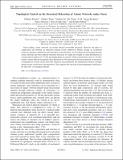Topological Control on the Structural Relaxation of Atomic Networks under Stress
Author(s)
Bauchy, Mathieu; Wang, Mengyi; Yu, Yingtian; Wang, Bu; Krishnan, N. M. Anoop; Masoero, Enrico; Ulm, Franz-Josef; Pellenq, Roland Jm; ... Show more Show less
DownloadPhysRevLett.119.035502.pdf (444.2Kb)
PUBLISHER_POLICY
Publisher Policy
Article is made available in accordance with the publisher's policy and may be subject to US copyright law. Please refer to the publisher's site for terms of use.
Terms of use
Metadata
Show full item recordAbstract
Upon loading, atomic networks can feature delayed irreversible relaxation. However, the effect of composition and structure on relaxation remains poorly understood. Herein, relying on accelerated molecular dynamics simulations and topological constraint theory, we investigate the relationship between atomic topology and stress-induced structural relaxation, by taking the example of creep deformations in calcium silicate hydrates (C─S─H), the binding phase of concrete. Under constant shear stress, C─S─H is found to feature delayed logarithmic shear deformations. We demonstrate that the propensity for relaxation is minimum for isostatic atomic networks, which are characterized by the simultaneous absence of floppy internal modes of relaxation and eigenstress. This suggests that topological nanoengineering could lead to the discovery of nonaging materials.
Date issued
2017-07Department
Massachusetts Institute of Technology. Department of Civil and Environmental Engineering; MultiScale Materials Science for Energy and Environment, Joint MIT-CNRS LaboratoryJournal
Physical Review Letters
Publisher
American Physical Society
Citation
Bauchy, Mathieu et al. “Topological Control on the Structural Relaxation of Atomic Networks under Stress.” Physical Review Letters 119.3 (2017): n. pag.
Version: Final published version
ISSN
0031-9007
1079-7114